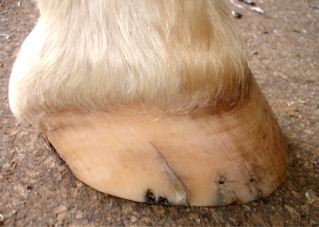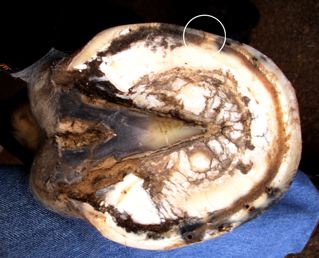Site Menu:
| This is an archived Horseadvice.com Discussion. The parent article and menus are available on the navigation menu below: |
| HorseAdvice.com » Diseases of Horses » Lameness » Diseases of the Hoof » Hoof Disease Topics Not Covered Above » |
| Discussion on Vertical Hoof Wall Crack | |
| Author | Message |
| New Member: eagle3 |
Posted on Wednesday, May 23, 2007 - 6:51 pm: My 6 yr old Dutch WB has crack on the inside of his LF hoof. He has had the crack since he was purchased 2.5 yrs ago. The top of the crack is approx an inch from the coronary band and has always maintained that distance. It never grows out. The horse was barefoot unit about 1.5 yrs ago when we started having him shod in hopes of stabilizing the crack so it would grow out. It has not made a difference. Two photos of the crack taken prior to his last shoeing are attached. The one of bottom of the hoof has the crack circled. As you can see the hoof wall is thin at this point, however the wall on his RF is the same and has no crack.The crack does not seem to cause the horse any pain. His gaits are fine, he moves nicely and does not favor it in any way. My questions are: 1) Is this a potential problem? 2) How can I encourage it to grow out? Naturally I'd like to see it grow out. You advise would be much appreciated.  
|
| Member: dres |
Posted on Wednesday, May 23, 2007 - 7:44 pm: I would say IF it was all the way to the top it is a scar.. but this does not look like its coming from the cornet.. you say it never grows out>??On the first day God created horses, on the second day he painted them with spots. |
| Moderator: DrO |
Posted on Thursday, May 24, 2007 - 6:34 am: Welcome William,Before we get into this I have a few questions:
DrO |
| New Member: eagle3 |
Posted on Thursday, May 24, 2007 - 11:08 pm: Hello Dr O, thanks for your prompt response. Here are my best answers to your questions.1. My reason for bringing up the fact the right fore has the same wall profile as the cracked left fore was point out the right exhibits no problem. Also that the thin wall does not appear to be caused by an injury which my trainer suggested could cause a thin wall. I was not expecting the right to crack. Should I? 2. We have not done much other to shoe the horse in hope of stabilizing the crack so it would grow out. As stated earlier he has been shod for 1.5 years and it crack has remained the same length and width. He has been getting a 6 oz serving of Glanzen 3 daily since he was purchased two years ago. A serving of Glanzen 3 has 30 mg of biotin, 25 grams of omega 3 fatty acid, 6.5 grams of methionine and a few other minerals and vitamins. Two months ago I started coating the crack with Tuff Stuff, but I have little faith it will help. 3. I believe his feet are balanced. My farrier is experience and takes care to measure angles and check for proper alignment both lateral-medial and front to rear. 4. I checked his walk and trot on a level flat surface as suggested. He lands flat at both the walk and the trot. His shoes show no uneven lateral-medial wear if that is any help. 5. Yes, the photo was taken after a long rainy period. His turnout was always wet. The photo may look bad, but he has no thrush. Both my farrier and vet say the quality of his horn is good. Hope that helps. |
| Moderator: DrO |
Posted on Saturday, May 26, 2007 - 9:19 am: Hello William,I posted yesterday but apparently did not push the button right. Lets see, pretty much what I said was that if your right foot looks just like you left, yes you are lucky you don't have a crack in it too. And since the trimming sounds OK the unusual thinness at this point must be congenital. But the right gives us hope we can repair the left by trimming out all the crack then repairing the defect and generally thickening the wall in the area with EquiLox. Concerning the black areas in the white line of the heel either the colors are way off, the mud in your area is solid black, or I bet my DVM that if you take a shoe nail you can dig out black, soft, smelly, degenerative horn in these areas. If that is not thrush, I don't know what it is. You see this a lot and the most common cause of foot abscesses is for these focal infections of thrush to ear through the insensitive horn to sensitive tissue and set up an infection that does not drain well without opening. DrO |
| New Member: eagle3 |
Posted on Monday, Jun 4, 2007 - 10:51 am: DrO,Thanks for the information. I have researched and will discuss the application with my farrier. One question, what do you mean by "trimming out the crack"? That is how deep and wide do we go? I am reluctant to be to aggressive when cutting into the hoof wall. BTW, I had a chance to discuss you evaluation with my regular vet. He concurred the defect was likely congenital. He also pointed out there is a slight flare in the hoof in the area of the crack, which would contribute to flexing and thus a continuous opening of the crack as the hoof grows. I did not give you a photo which showed this flare. WmP |
| Member: maggienm |
Posted on Monday, Jun 4, 2007 - 12:52 pm: How to trim out he crack is my question also.Thanks |
| Member: erika |
Posted on Monday, Jun 4, 2007 - 3:02 pm: Hmmm..let me guess...I'd bet William gets the advice given to all of us with some junk growing under the hoof wall that causes cracks.That would be to remove wall until all areas underneath are clear of any black, chalky, or dead tissue, right? Then treat with betadine until healthy hoof wall grows in. Scary stuff to all of us, but if you search you'll find recent success stories and pictures of cases. |
| Moderator: DrO |
Posted on Monday, Jun 4, 2007 - 8:54 pm: Erika, going over some of the more common disorders repeatedly does get a bit monotonous sometimes. However, everyone has a special case, a special worry, or at the very least a very special horse. But William does have a bit of a different problem...I think. If you get to the bottom and find cheesy white line let's start over. He has a great big horse with big hooves but what appears to be a congenitally thin wall in the quarters, prone to cracking from nothing more than it is too weak to do the work it was meant to do.William, there are several ways to do this crack. You can use either a hoof knife or a Dremel tool with a stainless steel burr. I would do the big work with a good sharp narrow blade knife and the fine work with a small round burr. Essentially you remove the least amount of horn necessary to remove all the defect from the wall. You start at the surface of the wall, pare out in the direction of the crack, adjusting your strokes as you go down to keep the crack in the middle of the paring. You stop paring when there is no more crack. Do you have someone there familiar with EquiLox? It does seem to be a bit of a learning curve to apply it correctly with cleanliness the hardest lesson to learn. Though I still don't see any flare on the above images, by all means all flare should be rasped out and kept out. DrO |
| Member: ilona |
Posted on Thursday, Jun 7, 2007 - 10:59 pm: I am watching this thread with bated breath as my oft-times referenced large TWH has a persistent crack and one thin hoof wall and no farrier has mentioned a problem in 4 years until his last scheduled shoeing (new farrier). My farrier (yet another new one) will be here next Tuesday so I will be videotaping Takumba before his arrival. I am most appreciative of this info.Erika, I, like you, watched that WLD thread (which I now believe was your horse? my memory fails me) and learned much, and yet stupidly never thought that it applied to Takumba. Now I am convinced more than ever that the need for repetition is because it works! |
| Member: erika |
Posted on Friday, Jun 8, 2007 - 8:20 am: Ilona, I did have a thread entitled "WLD", but in my case I think it was not infected horn, but just too much hoof flare that was causing the crack since we were able to finally get it grown out with vigilant trimming.But like you, I read and reread all the other WLD threads and think I learned a lot. Good luck to all of you out there with hoof cracks! |
Horseadvice.com
is The Horseman's Advisor
Helping Thousands of Equestrians, Farriers, and Veterinarians Every Day
All rights reserved, © 1997 -
is The Horseman's Advisor
Helping Thousands of Equestrians, Farriers, and Veterinarians Every Day
All rights reserved, © 1997 -
